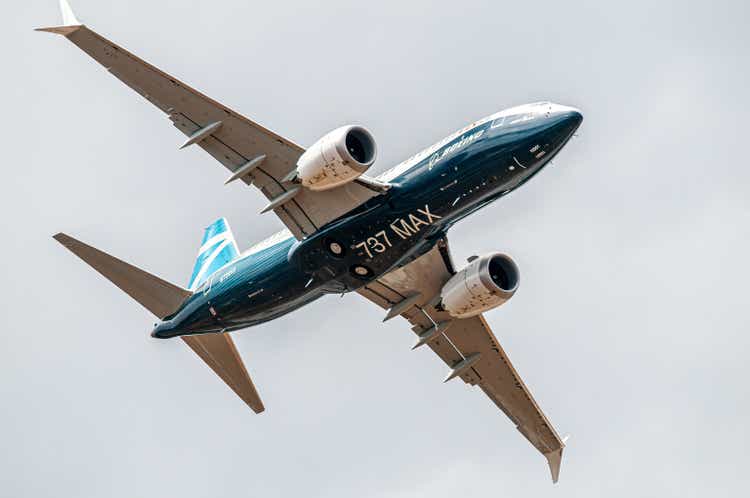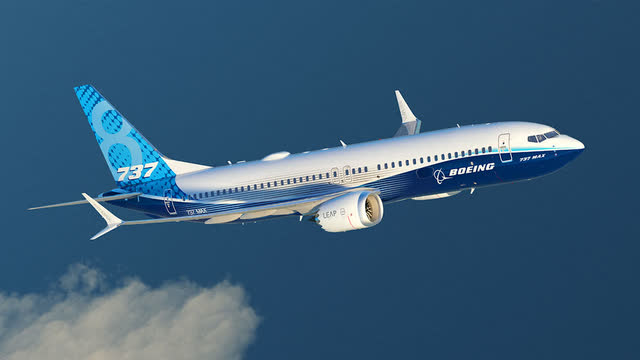Boeing Stock Tumbles: A New Boeing 737 MAX Crisis?
Summary
- Boeing 737 deliveries are partially halted after new issue was found.
- The system for detection and reporting issues is working, but given that this happens on the MAX is a big challenge.
- The financial impact is currently unknown, but could be significant.
- Looking for a helping hand in the market? Members of The Aerospace Forum get exclusive ideas and guidance to navigate any climate. Learn More »

Wirestock
Recently, I covered Boeing’s (NYSE:BA) March order and delivery numbers and generally those numbers looked positive to me. It gave analysts some confidence that Boeing would be able to reach its full-year delivery target. Days later, there's pressure on that delivery target as Boeing has halted deliveries for some Boeing 737 MAX airplanes following the detection of a new quality issue. In this report, I will briefly discuss the flaw and why this is bad for Boeing, but also for everyone involved. Right now, there's not a lot known about the impact of the latest issue so collecting and displaying data should provide at least some light.
Quality Lapse At Spirit AeroSystems
The most recent issue centers on fittings that are used to attach the vertical stabilizer to the fuselage and affects the Boeing 737 MAX 7, Boeing 737 MAX 8, the Boeing 737 MAX 8 200 and the P-8A. It seems that the Boeing 737 MAX 9 is not affected, and while the Boeing 737 MAX 7 is not yet certified, the fact that the issues affect both variants of the MAX 8 is already worrisome. Not necessarily form a safety perspective, as Boeing and the regulator made it clear there is no immediate flight safety issue, but because the delivery schedule might be compromised and it really makes one wonder on how thorough the processes to assure manufacturing quality, conformance and integrity are.
The Bigger Problem For Boeing
Probably important to highlight is that Boeing and Spirit AeroSystems followed the procedure here. A non-conformance was detected caused by deviating production methods and Spirit AeroSystems identified this, briefed Boeing and the original equipment manufacturer subsequently notified the FAA.
So, the system worked as it is supposed to. The bigger problem, beyond any financial impact, is the fact that this issue exists in the first place.
Dominic Gates from The Seattle Times says that the issue might date back four years. So, the reality is that while the Boeing 737 MAX was analyzed from nose to tail, there still are issues, and that does not only reflect badly on Boeing and its supplier but also on the FAA. Even after scrutinizing the Boeing 737 MAX thoroughly it was not thorough enough to catch this mistake in the quality of manufacturing. It makes one wonder what the FAA really did analyze and how much more they might have missed. In the years that I have been covering the Boeing 737 MAX, the repeated argument I see readers making is that this is the most scrutinized jet in the skies and therefore it must be the safest going forward. Either the jet is not inspected as thoroughly as one would think or the FAA has a bigger problem that it did an even worse job on other airplanes. The fact that this issue could still occur is damning, not just for Boeing or Spirit but also for the FAA. It puts a big dent in the confidence and perception of the expertise of the regulator.
Boeing is facing continued challenges. Earlier this year Dreamliner deliveries were halted and Boeing 767 deliveries recommenced in March which gave the impression that the company could really focus on getting airplanes out of the door again. The new issues on the Boeing 737 MAX put that on hold again and also show that there's a spiral that Boeing is not being able to break and it has not been able to do so for the past four years.
The Exact Impact On Boeing Deliveries Is Not Known

Boeing
The exact scale of the issue is not known. What's known is that it affects the Boeing 737 MAX 8 which is the core of the Boeing 737 MAX product line up. Also the high density variant of the MAX 8, which Ryanair (RYAAY) uses, is affected as well as the P-8A which is a multi-role maritime patrol aircraft based on the Boeing 737 Next Generation.
Ryanair recently started negotiations with Boeing again. Earlier talks stalled because Boeing refused to meet the price point desired by Ryanair. If deliveries are slipping, it means that the strength that Boeing built for new negotiations with the Irish low-cost carrier is eroded.
Furthermore, if this is something that requires additional out of sequence work that also could indicate that more abnormal production costs will need to be absorbed. For the time being, the delivery and production numbers will be lower.
A Possible Significant Impact For Boeing
Boeing has shown strong Q1 delivery numbers. Q1 tends to be the weakest quarter for commercial airplane deliveries, so the strong quarterly numbers gave analysts confidence that Boeing would reach its delivery target of 400 to 450 Boeing 737 MAX deliveries. The company already delivered 111 Boeing 737 MAX airplanes in Q1 and another 10 units in the first two weeks of April for a total of 121 units meaning that to reach the lower end of the targeted range Boeing would need another 279 deliveries.
Right now, 30 Boeing 737 MAX airplanes are produced per month or at least that's the intended production rate and each month we should have around 10 deliveries for a total of 40 deliveries per month. It seems that the biggest members of the MAX family, namely the MAX 9 and the MAX 10, are not affected. The MAX 10 is not yet certified, but the MAX 9 accounts for 20% of the deliveries so for that this year.
That leaves 36 airplanes per month on the commercial side that are affected or putting a pressure of $2 billion on revenues for each month without P-8A Poseidon and Boeing 737 MAX 8 deliveries. So, the longer this will drag on, the more impactful this is going to be for Boeing. Since a significant number of airplanes is affected, there's a chance that Boeing might actually see deliveries slipping into next year. The way I look at it is that if we have a one month slip on deliveries, we will look at deliveries slipping from the higher end of the range to the lower end of the guided delivery range for the Boeing 737, and if we have a slip of another month it could result in Boeing missing its delivery target for the year.
Boeing Leadership Has Booked Little Progress
In a recent report, I already expressed my view that the board was not critical enough on Calhoun’s functioning, and if you add the newest issues for the Boeing 737 MAX to the list then Calhoun has a series of cost overruns on the Defense programs on his name, the Boeing 777X delay and several Boeing 787 delivery stops. Not all issues can be blamed on the CEO, but the CEO was a board member before he became CEO so he doesn’t go free on the issues that Boeing faced before he took the lead. Things are getting better at Boeing, but the pace of recovery is way too slow, and while the CEO will spin the latest issue into a positive story on focus on safety, the reality is that under his leadership Boeing is not transforming fast enough or making a significantly better impression.
Conclusion: Boeing Stock Just Got More Risky
I believe that Boeing remains a long-term buy despite the challenges faced. Boeing will be reporting first quarter earnings on the 26th of April and while I do believe that Boeing will be very reserved with providing timelines on the current issues being fixed, I hope to hear more information on the most recent issues because at this moment we do know that a significant number of airplanes might be affected, but we don’t know whether the issues are such that it will jeopardize the 2023 delivery target and I think that is the least amount of info that Boeing should be providing. So beyond Q1 performance, we will closely watching the earnings call to see whether there are any changes to the guidance.
In my monthly order and delivery overview, I pointed out that I was looking for airplane deliveries that would be higher than 50 airplane deliveries but that's something that I don’t see happening with the newest issues being announced. With that, Boeing stock has become a riskier investment for short-term investors and expectation is that by the end of H1, Boeing might have fallen behind in the delivery race with Airbus.
If you want full access to all our reports, data and investing ideas, join The Aerospace Forum for the #1 aerospace, defense and airline investment research service on Seeking Alpha, with access to evoX Data Analytics, our in-house developed data analytics platform.
This article was written by
His reports have been cited by CNBC, the Puget Sound Business Journal, the Wichita Business Journal and National Public Radio. His expertise is also leveraged in Luchtvaartnieuws Magazine, the biggest aviation magazine in the Benelux.
Analyst’s Disclosure: I/we have a beneficial long position in the shares of BA, EADSF either through stock ownership, options, or other derivatives. I wrote this article myself, and it expresses my own opinions. I am not receiving compensation for it (other than from Seeking Alpha). I have no business relationship with any company whose stock is mentioned in this article.
Seeking Alpha's Disclosure: Past performance is no guarantee of future results. No recommendation or advice is being given as to whether any investment is suitable for a particular investor. Any views or opinions expressed above may not reflect those of Seeking Alpha as a whole. Seeking Alpha is not a licensed securities dealer, broker or US investment adviser or investment bank. Our analysts are third party authors that include both professional investors and individual investors who may not be licensed or certified by any institute or regulatory body.


